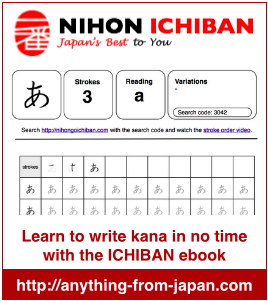The Japanese particle は – wa
Function of the は – wa particle

The particle は – wa indicates the main topic of a sentence. In English it would be similar to starting a sentence with “as for…”. Most of the times the main topic of the sentence is identical to what is called the subject in English.
How to use the particle は – wa
[topic of the sentence] + [は/wa] + rest of the sentence
Japanese Examples SENTENCES with the particle は – wa
| Kanji | 私は先生です。 |
| Furigana | わたしはせんせいです。 |
| Romaji | watashi wa sensei desu. |
| English | I am a teacher. (As for me, I am a teacher.) |
| Kanji | 明日は働きます。 |
| Furigana | あしたははたらきます。 |
| Romaji | ashita wa hatarakimasu. |
| English | Tomorrow I work. |
| Kanji | この映画は面白いです。 |
| Furigana | このえいがはおもしろいです。 |
| Romaji | kono eiga wa omoshiroi desu. |
| English | That movie is interesting. |
Lessons & tests for the Japanese particle は – wa
Learn more about Japanese particles
Learn more about the 188 particles used in the Japanese language.


kono eiga wa, (kono means this) can we also use sono eiga wa as translated in the example?
Yes, you could also use sono eiga instead of kono eiga.
How about “教師” instead of “先生”? The latter is a honorific of a kind, so maybe it is not polite to speak of oneself with the respect that comes with the word…
why we use wa particle?
it is used to indicate the subject of the sentence.
for e.g.watashi wa gakusei desu.
here watashi(i) is the subject or main topic of the sentence.therefore wa is written after it.for things there is a different rule…we use kore sore dore and are…u can search for them.
for e.g.kore wa nan desuka?(what is this?)
sore wa shinbun desu.(that is a newspaper)
why do we use ‘ha’ symbol to represent ‘wa’